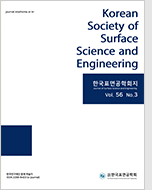
- Past Issues
- e-Submission
-

2021 Impact Factor 1.766
5-Year Impact Factor 1.674
Editorial Office
- +82-2-563-0935
- +82-2-558-2230
- submission@kssse.or.kr
- https://www.kssse.or.kr/

2021 Impact Factor 1.766
5-Year Impact Factor 1.674
The Korean Society of Surface Science and Engineering 2024;57(6):456-462. Published online: Dec, 31, 2024
DOI : 10.5695/JSSE.2024.57.6.456
Stainless steel used in the semiconductor industry requires high surface quality and corrosion resistance, making ultra-cleaning processes essential. This study investigated the effects of various electrolyte compositions with different ratios of phosphoric acid and sulfuric acid on the electropolishing performance and Cr/Fe ratio of stainless steel. As the phosphoric acid content increased, the optimal voltage range for maintaining stable current density narrowed, but surface roughness improved due to its oxidation-promoting effect. In contrast, higher sulfuric acid content resulted in limited improvements in surface quality and the Cr/Fe ratio. These findings present a method for optimizing electrolyte composition and passivation time to effectively enhance the surface quality and corrosion resistance of stainless steel required in the semiconductor industry.
Keywords Electropolishing; Phosphoric acid; Stainless steel; Surface roughness; Cr/Fe ratio